Lens Couples Power from Dielectric to Metal Waveguides
Metallic waveguides have long been transmission lines of choice for high-power microwave and millimeter-wave systems because of their low loss and high power-handling capabilities. Tradeoffs in using metallic waveguide include the relatively narrow bandwidths and weight that they add to high-frequency systems.
As an alternative, researchers at NASA’s Jet Propulsion Laboratory (JPL), Pasadena, Calif., developed dielectric waveguides based on long sections of dielectric material. They provide wide bandwidths and low signal loss compared to conventional metallic waveguide. Furthermore, interconnections between sections of the dielectric waveguide use lens coupling to minimize losses at the junctions by a factor of 10 or more compared to metallic-waveguide interconnections.
Conventional metallic waveguides may employ twists or bends to form connections between two sections of waveguide. When dielectric waveguide must be joined to a section of metallic waveguide, the ends of the dielectric waveguide are tapered and then inserted directly into the metallic waveguide, using a long transition to minimize coupling losses between the two media types.
NASA seeks to apply this technology to data-transmission links that cannot tolerate losses, such as in spacecraft, landers, and rovers for interplanetary exploration. It is seeking licensees interested in pursuing this technology commercially; more information can be found at http://technology.nasa.gov/patent/TB2016/NPO-TOPS-46.
See “Lens-Coupled Dielectric Waveguides,” NASA Tech Briefs, August 2016, p. 28.
About the Author
Jack Browne
Technical Contributor
Jack Browne, Technical Contributor, has worked in technical publishing for over 30 years. He managed the content and production of three technical journals while at the American Institute of Physics, including Medical Physics and the Journal of Vacuum Science & Technology. He has been a Publisher and Editor for Penton Media, started the firm’s Wireless Symposium & Exhibition trade show in 1993, and currently serves as Technical Contributor for that company's Microwaves & RF magazine. Browne, who holds a BS in Mathematics from City College of New York and BA degrees in English and Philosophy from Fordham University, is a member of the IEEE.


